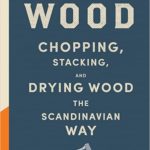From Living Woods issue 39
 Not Just for Woodies
Not Just for Woodies
Norwegian Wood: Chopping, Stacking and Drying
Wood the Scandinavian Way
by Lars Mytting
MacLehose Press
Review by Angus Hanton
If men have two big secrets – porn and firewood
– this book has at least given them permission to
talk openly about the latter and to admit that they get
intense pleasure from how they find, cut, dry and use
their logs. By getting his book into the mainstream,
Norwegian author and journalist Lars Mytting has
enabled men to come out of the closet and speak
openly about their wood. Actually it’s not just men:
there are couples with their logpiles amongst the
hundred or so photos. The logpile pictures draw you
in, partly because they are so neat and, sometimes,
artistic, but mainly because each one tells a story of
countless hours of hard, muscle-warming work.
Norwegian Wood progresses logically from the cold
of winter to the forest, and then onto chopping and
seasoning before climaxing with stoves and fires. Anyone
with a wood-burning stove should read this book for its
practical tips. For example, you should split your wood
before seasoning it for thorough drying and you should
generally put two logs on a fire at the same time so
they burn better. We are challenged by two huge claims
about firewood. First, Mytting spells out how using a
renewable fuel like wood contributes to the fight against
global warming.
“Even in oil-rich Norway an astonishing 25% of the
energy used to heat private homes comes from wood,
and half of that is wood chopped by private individuals.
And this harvesting is more than sustainable – Norway’s
annual consumption of wood is less than 0.5% of the
volume of standing trees in Norway.”
Second, he shows how the harvesting and preparation
of logs can be a central part of how we live our lives.
Mytting dedicates the book to his neighbour, Ottar,
an older man who once a year, in late spring, has birch
logs delivered to his front drive. We watch an ageing
Ottar process these logs and rather than finding himself
tired out by the task it restores his vitality. It is a lifegiving
ritual. This is in a Norwegian town where winter
temperatures are often around -30 degrees celsius so
keeping warm is a universal concern. At the end of the
book we rejoin Ottar to witness his final year of log
stacking. When he dies he leaves a legacy of at least
three years’ supply of firewood for his widow. Just as a
“woodfire is about so much more than heat”, the stories
in this book are about so much more than wood –
about how we interact with our neighbours, respect
nature, and how we care for future generations. Life,
and staying warm, is still a struggle for survival.
There has been a resurgence of interest in woodfuel
in Scandinavia: today’s firewood consumption in
Norway and Denmark is ten times what it was in 1976.
Current interest is so high that the National Public
Service broadcaster, NRK, even aired a twelve-hour
show dedicated to woodfuel. Four hours depicted all
aspects, including Lars Mytting demonstrating how to
light a fire, but the bulk of it (eight hours) was spent
with the camera focused on a log fire. People loved
it. Occasionally fuel was added and at one point the
camera operator cooked a sausage on the fire. Viewers
were avidly sending messages with advice on when to
add a log and how to manage the airflow. This growing
interest has been boosted by improved technology:
better and cheaper chainsaws, hydraulic splitters,
and more efficient stoves. But how to use these
tools most effectively is part of the mission of
the book. As Mytting says, “much of this book is
concerned with method”. It’s also about primaeval
feelings and our “instinctive affection for flames”.
Log burning probably goes back as far as humans
and it has allowed us to inhabit regions which would
otherwise be too far north. Historically “gathering
fuel was one of the most crucial of all tasks and the
calculation was simplicity itself: a little, and you
would freeze. Too little and you would die”. Within
the family unit a good reserve of fuel was essential
but in Nordic countries national reserves were also
built up at times of crisis. Enormous woodpiles
were created in Helsinki during World War II when
the annual harvest was a record 25 million cubic
metres. You need the book to see the pictures.
When you consider that Norway has a population
of only 5 million, sales of about 200,000 copies
suggest that about one in ten households owns
the book. The surprise best-seller has also
travelled well, with versions available in at least
ten languages. My own interest in Norwegian
Wood started when a Swiss friend of mine said it
was a “must read”. Although it’s been bought by
tens of thousands of “armchair woodchoppers”
it’s a practical guide for those of us who heat our
homes with woodfuel and have our very own, rather
modest, woodpiles.
That Lars Mytting is a Norwegian journalist explains
his love of a good anecdote as well as his deadpan
humour. His stories are as much about planning for the
future as they are about processing firewood. There
are dozens of graphic pictures that all log enthusiasts
will drool over. For many men, the logpiles and
woodfuel photos will be almost pornographic.